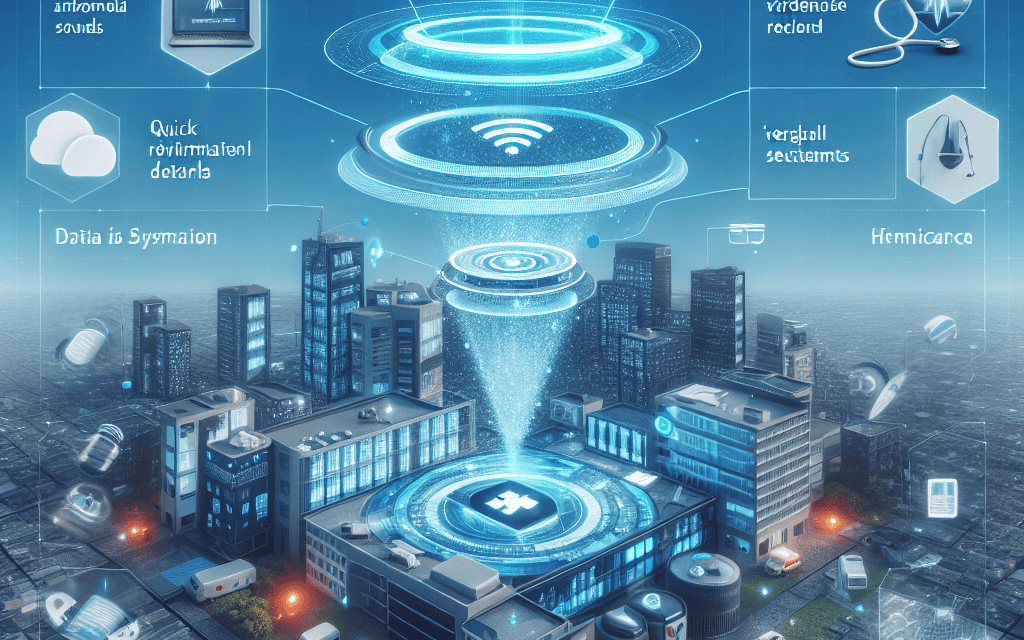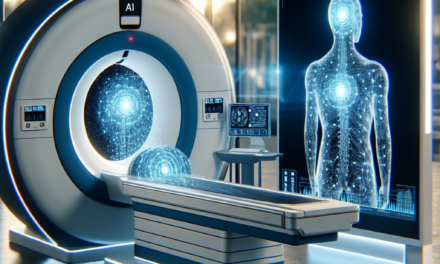AI Roundup: Emergency Ambient Recording and Enhanced EHR Features
The integration of artificial intelligence (AI) into healthcare has revolutionized various aspects of patient care, particularly in emergency settings and electronic health records (EHR). This article delves into two significant advancements: emergency ambient recording and enhanced EHR features. We will explore their implications, benefits, challenges, and future prospects, providing a comprehensive overview of how these technologies are shaping the healthcare landscape.
1. Understanding Emergency Ambient Recording
Emergency ambient recording refers to the use of AI-driven technologies to capture and analyze audio and visual data in emergency medical situations. This innovative approach aims to improve patient outcomes, enhance communication among healthcare providers, and streamline the documentation process.
1.1 The Role of AI in Emergency Ambient Recording
AI plays a crucial role in emergency ambient recording by enabling real-time data capture and analysis. Through advanced algorithms, AI can process audio and visual inputs to identify critical information, such as patient vitals, medication administration, and procedural steps. This capability allows healthcare professionals to focus on patient care rather than documentation.
- Real-time Data Capture: AI systems can continuously record ambient sounds and visuals in emergency settings, ensuring that no critical information is missed.
- Natural Language Processing (NLP): NLP algorithms can transcribe spoken words into text, facilitating accurate documentation of patient interactions and clinical decisions.
- Contextual Awareness: AI can analyze the context of recorded data, identifying key events and actions that are relevant to patient care.
1.2 Benefits of Emergency Ambient Recording
The implementation of emergency ambient recording offers numerous benefits for healthcare providers and patients alike. Some of the most significant advantages include:
- Improved Documentation: By automating the documentation process, healthcare providers can reduce the risk of errors and omissions, leading to more accurate patient records.
- Enhanced Communication: Ambient recording facilitates better communication among team members by providing a clear record of discussions and decisions made during emergencies.
- Training and Education: Recorded data can be used for training purposes, allowing new staff to learn from real-life scenarios and improving overall team performance.
1.3 Challenges and Considerations
Despite its potential benefits, emergency ambient recording also presents several challenges that must be addressed:
- Privacy Concerns: The recording of sensitive patient information raises ethical and legal questions regarding patient consent and data security.
- Integration with Existing Systems: Implementing ambient recording technologies requires seamless integration with existing EHR systems, which can be complex and costly.
- Data Overload: The volume of data generated by ambient recording can be overwhelming, necessitating effective data management strategies to extract meaningful insights.
1.4 Case Studies: Successful Implementations
Several healthcare institutions have successfully implemented emergency ambient recording technologies, yielding positive outcomes:
- Case Study 1: A major urban hospital integrated AI-driven ambient recording in its emergency department, resulting in a 30% reduction in documentation errors and improved patient satisfaction scores.
- Case Study 2: A rural healthcare facility utilized ambient recording for training purposes, leading to enhanced team performance and a 20% decrease in response times during emergencies.
1.5 Future Prospects of Emergency Ambient Recording
The future of emergency ambient recording looks promising, with ongoing advancements in AI technology. Potential developments include:
- Enhanced AI Algorithms: Continued improvements in machine learning and NLP will lead to more accurate data capture and analysis.
- Broader Adoption: As awareness of the benefits grows, more healthcare facilities are likely to adopt ambient recording technologies.
- Integration with Telemedicine: Combining ambient recording with telemedicine platforms could enhance remote consultations and improve patient care in underserved areas.
2. Enhanced EHR Features: Transforming Patient Care
Electronic health records (EHR) have become a cornerstone of modern healthcare, providing a digital platform for storing and managing patient information. Enhanced EHR features, powered by AI, are transforming how healthcare providers interact with patient data, leading to improved care delivery and outcomes.
2.1 AI-Driven Data Analytics in EHR
AI-driven data analytics is revolutionizing EHR systems by enabling healthcare providers to extract valuable insights from patient data. These insights can inform clinical decision-making, identify trends, and improve patient outcomes.
- Predictive Analytics: AI algorithms can analyze historical patient data to predict future health events, allowing for proactive interventions.
- Risk Stratification: Enhanced EHR features can identify high-risk patients based on various factors, enabling targeted care management strategies.
- Population Health Management: AI can aggregate data across populations to identify health trends and inform public health initiatives.
2.2 Streamlined Clinical Workflows
Enhanced EHR features streamline clinical workflows by automating routine tasks and improving communication among healthcare providers. This efficiency allows providers to focus more on patient care rather than administrative duties.
- Automated Documentation: AI can automatically populate EHR fields based on voice recognition or ambient recording, reducing the time spent on documentation.
- Interoperability: Enhanced EHR systems can seamlessly share data with other healthcare providers, improving care coordination and reducing duplication of services.
- Task Management: AI-driven task management tools can prioritize clinical tasks based on urgency and importance, ensuring timely patient care.
2.3 Patient Engagement and Empowerment
Enhanced EHR features also focus on improving patient engagement and empowerment. By providing patients with access to their health information, healthcare providers can foster a more collaborative approach to care.
- Patient Portals: Enhanced EHR systems often include user-friendly patient portals that allow patients to view their health records, schedule appointments, and communicate with providers.
- Personalized Health Recommendations: AI can analyze patient data to provide personalized health recommendations, encouraging patients to take an active role in their care.
- Remote Monitoring: Integration with wearable devices allows for continuous monitoring of patient health, enabling timely interventions when necessary.
2.4 Addressing Challenges in EHR Implementation
While enhanced EHR features offer numerous benefits, several challenges must be addressed to ensure successful implementation:
- Data Security: Protecting patient data from breaches is a top priority, necessitating robust security measures and compliance with regulations.
- User Training: Healthcare providers must receive adequate training to effectively utilize enhanced EHR features, ensuring they can maximize the benefits of the technology.
- Cost Considerations: The initial investment in enhanced EHR systems can be significant, requiring careful budgeting and planning.
2.5 Future Trends in EHR Technology
The future of EHR technology is poised for continued evolution, with several trends on the horizon:
- AI Integration: As AI technology advances, we can expect even more sophisticated features that enhance clinical decision-making and patient care.
- Blockchain Technology: The use of blockchain for secure data sharing could revolutionize EHR systems, enhancing data security and interoperability.
- Telehealth Integration: The integration of telehealth services into EHR systems will facilitate remote care delivery and improve access to healthcare services.
3. The Impact of AI on Emergency Care Delivery
The integration of AI technologies in emergency care delivery has the potential to significantly enhance patient outcomes and streamline processes. By leveraging AI, healthcare providers can make more informed decisions, respond more quickly to emergencies, and improve overall care quality.
3.1 AI-Powered Decision Support Systems
AI-powered decision support systems (DSS) are becoming increasingly prevalent in emergency care settings. These systems analyze patient data in real-time to provide healthcare providers with evidence-based recommendations for diagnosis and treatment.
- Clinical Decision-Making: AI DSS can assist providers in making accurate diagnoses by analyzing symptoms, medical history, and lab results.
- Triage Optimization: AI algorithms can prioritize patients based on the severity of their conditions, ensuring that those in critical need receive timely care.
- Medication Management: AI can help prevent medication errors by cross-referencing patient allergies and interactions with prescribed medications.
3.2 Enhancing Patient Safety
AI technologies play a vital role in enhancing patient safety in emergency care settings. By providing real-time alerts and monitoring, AI can help prevent adverse events and improve patient outcomes.
- Real-Time Monitoring: AI systems can continuously monitor patient vitals and alert providers to any concerning changes, enabling prompt interventions.
- Predictive Analytics for Adverse Events: AI can analyze historical data to identify patients at risk for complications, allowing for proactive measures to be taken.
- Standardized Protocols: AI can help ensure adherence to clinical guidelines and protocols, reducing variability in care delivery.
3.3 Case Studies: AI in Emergency Care
Several healthcare organizations have successfully implemented AI technologies in their emergency departments, leading to improved patient care:
- Case Study 1: A large metropolitan hospital utilized AI-powered triage systems, resulting in a 25% reduction in wait times and improved patient satisfaction scores.
- Case Study 2: An academic medical center implemented AI-driven decision support tools, leading to a 15% decrease in diagnostic errors in the emergency department.
3.4 Challenges in AI Adoption in Emergency Care
While the benefits of AI in emergency care are clear, several challenges must be addressed to facilitate successful adoption:
- Integration with Existing Systems: Ensuring that AI technologies seamlessly integrate with current EHR systems is crucial for maximizing their effectiveness.
- Provider Acceptance: Gaining buy-in from healthcare providers is essential, as resistance to change can hinder the implementation of new technologies.
- Data Quality: The effectiveness of AI algorithms relies on high-quality data; therefore, ensuring accurate and complete data entry is critical.
3.5 The Future of AI in Emergency Care
The future of AI in emergency care is bright, with ongoing advancements expected to further enhance patient outcomes:
- Increased Automation: As AI technologies evolve, we can expect greater automation of routine tasks, allowing providers to focus on complex patient care.
- Enhanced Predictive Capabilities: Future AI systems will likely offer even more sophisticated predictive analytics, enabling proactive interventions for at-risk patients.
- Collaboration with Telemedicine: The integration of AI with telemedicine platforms will enhance remote emergency care delivery, improving access for patients in underserved areas.
4. The Role of AI in Improving EHR Usability
Usability is a critical factor in the success of EHR systems. AI technologies are being leveraged to enhance the usability of EHRs, making them more intuitive and user-friendly for healthcare providers.
4.1 User-Centric Design Principles
AI can help inform user-centric design principles for EHR systems, ensuring that they meet the needs of healthcare providers. By analyzing user behavior and preferences, AI can guide the development of more intuitive interfaces.
- Personalized Dashboards: AI can create personalized dashboards that display relevant information based on individual provider preferences and workflows.
- Contextual Help: AI-driven contextual help features can provide real-time assistance to users, reducing frustration and improving efficiency.
- Adaptive Learning: EHR systems can learn from user interactions, continuously improving their interfaces based on provider feedback and usage patterns.
4.2 Reducing Cognitive Load
One of the primary challenges healthcare providers face with EHR systems is cognitive overload. AI technologies can help reduce this burden by streamlining workflows and automating repetitive tasks.
- Automated Data Entry: AI can automate data entry processes, allowing providers to focus on patient interactions rather than administrative tasks.
- Smart Alerts: AI can filter alerts and notifications, ensuring that providers only receive relevant information that requires their attention.
- Intelligent Search Functions: AI-powered search functions can quickly retrieve relevant patient information, reducing the time spent navigating EHR systems.
4.3 Enhancing Interoperability
Interoperability is essential for effective EHR systems, allowing for seamless data sharing among healthcare providers. AI technologies can facilitate interoperability by standardizing data formats and improving communication between systems.
- Data Standardization: AI can help standardize data entry formats, ensuring consistency across different EHR systems.
- Real-Time Data Exchange: AI can enable real-time data exchange between EHR systems, improving care coordination and reducing duplication of services.
- API Development: AI can assist in the development of application programming interfaces (APIs) that facilitate data sharing between different healthcare systems.
4.4 Addressing User Feedback
Incorporating user feedback is crucial for improving EHR usability. AI technologies can analyze user feedback and identify common pain points, guiding future enhancements.
- Sentiment Analysis: AI can perform sentiment analysis on user feedback to gauge overall satisfaction and identify areas for improvement.
- User Surveys: AI can automate the distribution and analysis of user surveys, streamlining the feedback collection process.
- Continuous Improvement: AI can facilitate a continuous improvement cycle by regularly analyzing user feedback and implementing necessary changes to the EHR system.
4.5 The Future of EHR Usability
The future of EHR usability is likely to be shaped by ongoing advancements in AI technology:
- Voice Recognition: The integration of advanced voice recognition technology will allow providers to interact with EHR systems more naturally and efficiently.
- Augmented Reality (AR): AR technologies may be utilized to enhance EHR interfaces, providing visual representations of patient data in real-time.
- AI-Driven Personal Assistants: Future EHR systems may incorporate AI-driven personal assistants that can help providers navigate the system and retrieve information quickly.
5. Conclusion: The Future of AI in Healthcare
The integration of AI technologies into emergency ambient recording and enhanced EHR features is transforming the healthcare landscape. These advancements are improving patient care, enhancing communication among healthcare providers, and streamlining clinical workflows. However, challenges such as privacy concerns, data security, and provider acceptance must be addressed to ensure successful implementation.
As we look to the future, the potential for AI in healthcare is vast. Continued advancements in AI technology will likely lead to even more sophisticated tools that enhance patient outcomes and improve the overall quality of care. By embracing these innovations, healthcare providers can better meet the needs of their patients and navigate the complexities of modern healthcare delivery.
In summary, the ongoing evolution of AI in emergency ambient recording and EHR features represents a significant step forward in the quest for improved patient care. As these technologies continue to develop, they hold the promise of a more efficient, effective, and patient-centered healthcare system.





